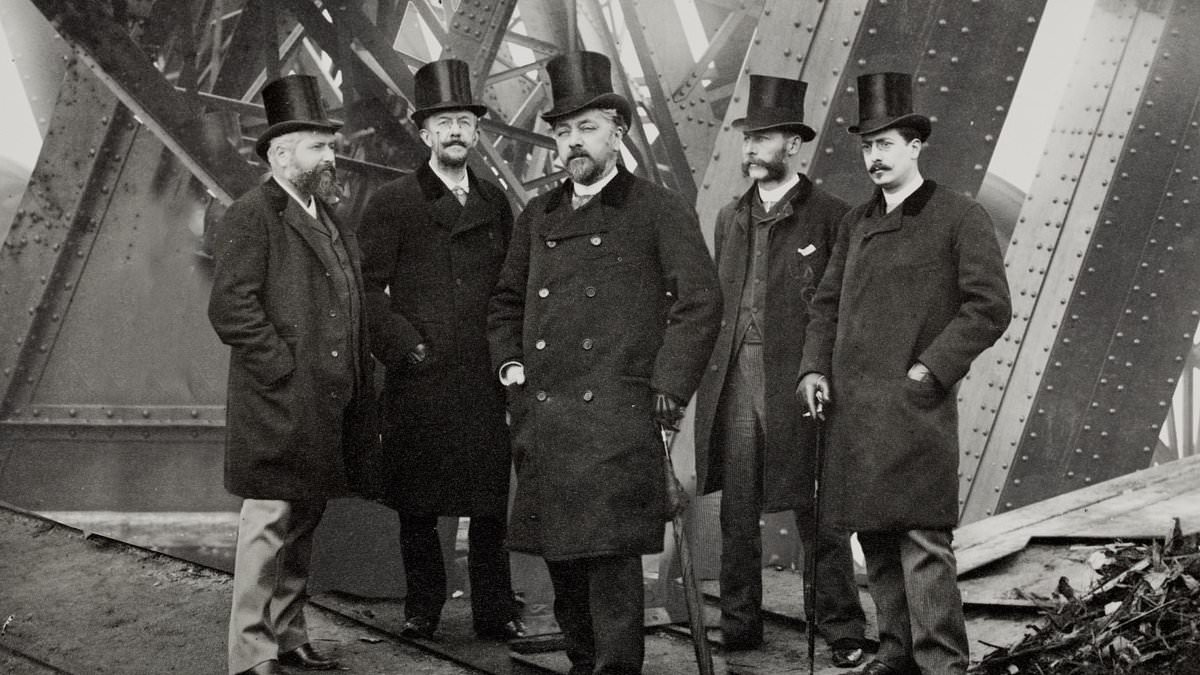Eiffel Tower: Building The Impossible (BBC4)
Did you see the French National Orchestra dripping wet in see-through plastic ponchos, and that grand piano filling up with water like a rain barrel?
Yes, the Olympics opening ceremony was a wash-out. What fun! Every true Brit enjoys the spectacle when France tries to look très magnifique and ends up with oeuf on le visage.
But it could have been so much worse. All that might have taken place in the shadow of a 1,000ft tall Wicked Willie.
Geraldine James, narrating Eiffel Tower: Building The Impossible, revealed that Parisians hated their iron monument so much that, a decade after it was built, a competition to cover it up was held, to coincide with the city’s 1900 World Fair. The oversized pylon itself was condemned as ‘useless and monstrous’.

This entertainingly quirky documentary combined archive footage with CGI stills to tell the story of Gustave Eiffel (centre)

The Eiffel Tower seen from the neighbouring stadium hosting beach volleyball during the Paris 2024 Olympics
One design to hide it involved a giant belfry surmounted by a clock. Another plan was to encase the tower in a tubular shaft, topped by a large brass globe. That looked… well, vulgar is too polite a word. It was downright obscene.
This entertainingly quirky documentary combined archive footage with CGI stills to tell the story of Gustave Eiffel, a visionary engineer who made Isambard Kingdom Brunel look like a bloke who did a bit of tinkering in his shed at weekends.
Not only did Eiffel bully Paris into letting him build what was, at the time, the tallest structure in the world, he also masterminded the creation of the Statue of Liberty and designed a system of locks for the Panama Canal.
Much of the technical explanation was in French, with subtitles, which meant if you wanted to understand Eiffel’s innovations, you had to concentrate.

Not only did Eiffel bully Paris into letting him build what was, at the time, the tallest structure in the world, he also masterminded the creation of the Statue of Liberty and designed a system of locks for the Panama Canal

The Eiffel Tower lit up and displaying the Olympic rings during the Opening Ceremony on Friday
The key, apparently, was the strength of his criss-crossing girders, bracing the outer spars. These made his structures comparatively lightweight, though the tower still weighs more than 7,000 tons. Every part had to fit together perfectly, with measurements accurate to a tenth of a millimetre.
Read More
CHRISTOPHER STEVENS reviews last night's TV: Computer graphics made this train catastrophe look like a video game

One professor took us to Vietnam, once a French colony, to show how two of Eiffel’s early bridges have survived the war and still span the river in Ho Chi Minh City, formerly Saigon. The Prof appeared to have very little confidence in his own ability to survive there — he rode pillion on a moped, zig-zagging through the teeming traffic, with both hands gripping the saddle like a nun on a racehorse.
The story was crammed with odd details. Eiffel himself was disgraced, three years after the tower was completed — convicted of complicity in fraud and sentenced to two years in jail.
His tower was meant to be pulled down after 20 years, but was granted a stay of execution because it proved useful as a radio antenna.
Computer graphics showed him as a fellow with a distinguished beard and a top hat. These images were apparently created with AI software. It saves the cost of hiring actors, I suppose, but it left old Gustave looking like a digital waxwork.
